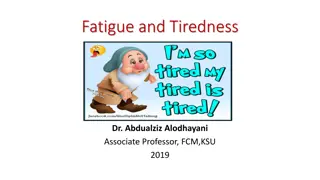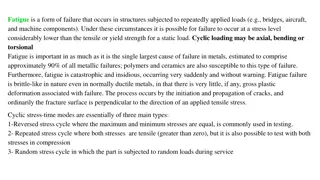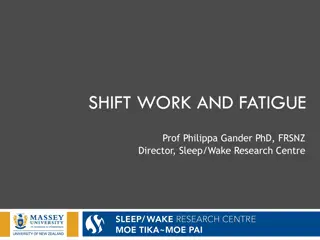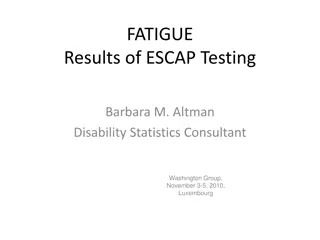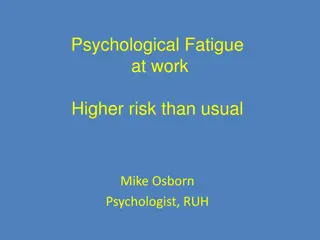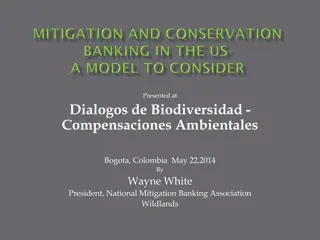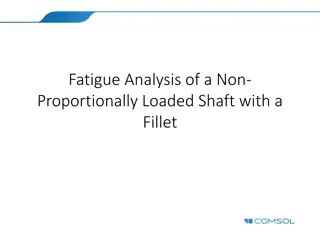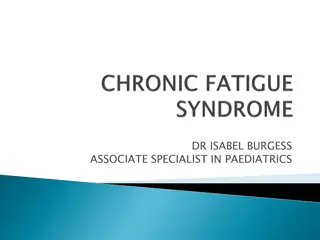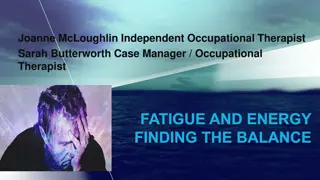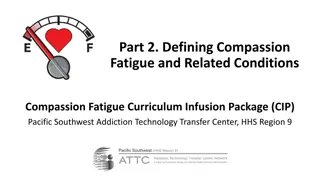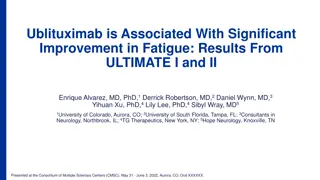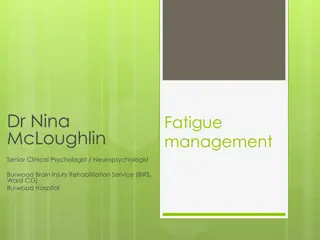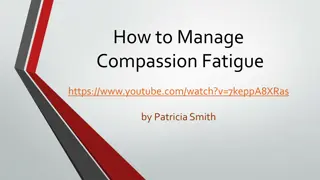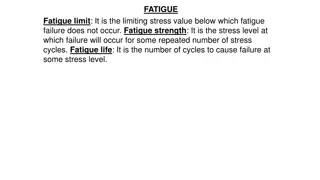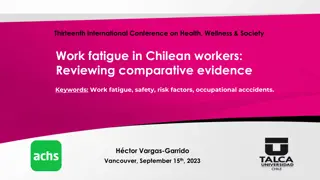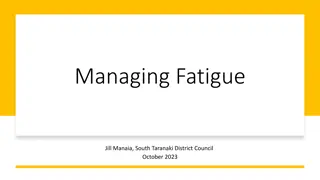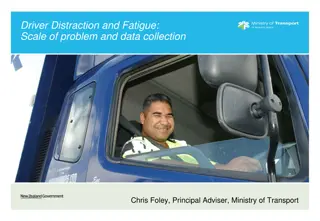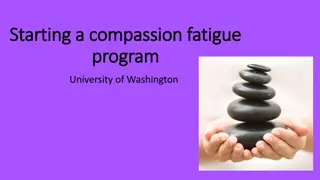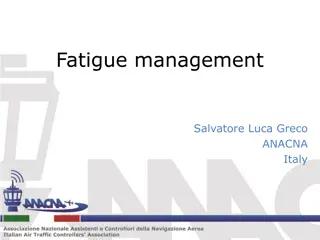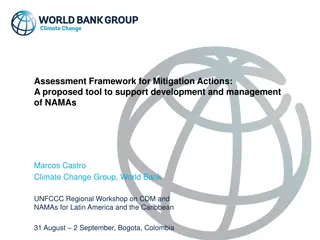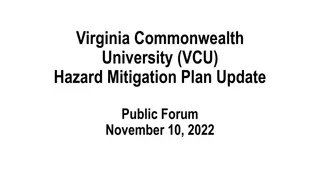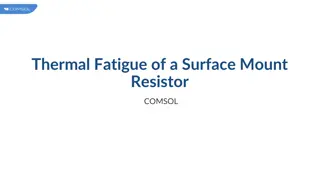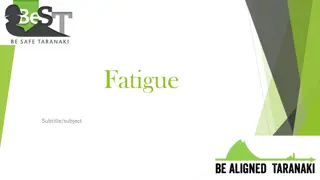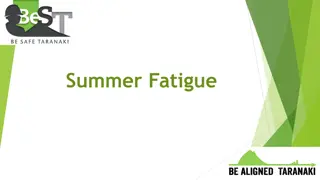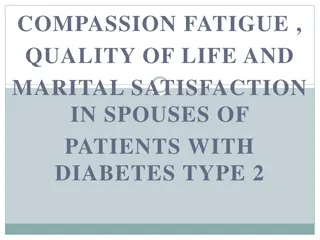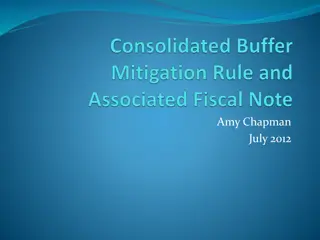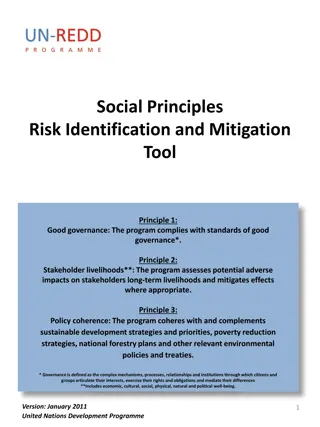Managing Human Fatigue Risk Through Safety and Wearable Technology
Explore the framework of human fatigue, the costs associated with fatigue-related accidents, performance impairments due to sleep deprivation, and the monetary losses incurred by businesses. Learn about solutions and systems integrating technology to monitor and manage human fatigue risk effectively
0 views • 20 slides
Understanding Fatigue: Definitions, Causes, and Management
Fatigue is defined as an unpleasant symptom that affects an individual's normal functioning capacity. It can manifest as tiredness, weakness, or lack of energy. Common causes of fatigue include sleep loss, heavy physical or mental work, and chronic conditions like Chronic Fatigue Syndrome. The manag
3 views • 36 slides
Implementation of Redi Fatigue Management System at OK Tedi Mine
Significant incidents related to the operation of vehicles and mobile equipment at OK Tedi Mine prompted the exploration of more effective fatigue management controls. The Redi Fatigue Risk Management Process, utilizing wearables and personalized fatigue prediction, aims to reduce fatigue-related in
0 views • 7 slides
Virginia Commonwealth University Hazard Mitigation Plan Update
The Virginia Commonwealth University (VCU) Hazard Mitigation Plan (HMP) Update Public Comment Meeting #1 took place on April 5, 2022. The meeting included introductions, overview of hazard mitigation planning, work plan details, data and information needs, next steps, and action items. Various commi
0 views • 20 slides
Recognizing and Addressing Compassion Fatigue, Burnout, and Role Overload in Caregivers
Understanding the concepts of compassion fatigue, burnout, and role overload is crucial for caregivers to prevent and manage the negative impacts of their work. Compassion fatigue involves emotional and physical exhaustion, while burnout results in a sense of overwhelming stress and detachment. Role
0 views • 15 slides
Comprehensive Risk Assessment and Hazard Mitigation Planning
This work delves into risk assessment and hazard mitigation planning supported by the National Science Foundation. It covers the importance of hazard identification, risk assessment, and mitigation planning components. Mitigation actions are outlined to reduce risks to life and property, prevent dam
2 views • 20 slides
Understanding Fiber Characteristics in Fiber Optics and Laser Instrumentation
This module explores the mechanical characteristics such as strength, static fatigue, and dynamic fatigue of glass fibers in fiber optics. It discusses the cohesive bond strength of glass fibers, static fatigue under humid conditions, and dynamic fatigue during installation and operation. The transm
0 views • 34 slides
Understanding Fatigue Failure in Structural Materials
Fatigue failure is a common form of structural failure caused by repetitive loading, especially in metals but also affecting polymers and ceramics. This type of failure can occur at stress levels much lower than the material's static strength, often leading to sudden and catastrophic breaks without
0 views • 9 slides
Managing Fatigue and Shift Work: Impact on Safety and Wellbeing
Understanding the legal requirements, effects of fatigue and shift work, and ways to manage fatigue is crucial for ensuring workplace safety and employee wellbeing. Fatigue, a state of reduced performance capability, can result from various factors, including sleep loss and workload. Shift work pose
6 views • 19 slides
FATIGUE Results & Cognitive Testing Insights
The content discusses the results of fatigue testing conducted by Barbara M. Altman in Luxembourg, focusing on questions used, cognitive test results, and field testing questionnaires. Insights reveal various factors contributing to tiredness, such as physical activity, lack of sleep, health-related
1 views • 15 slides
Understanding Psychological Fatigue at Work: Insights from Mike Osborn, Psychologist
Small behaviors and everyday experiences can significantly impact our health, especially in high-performance work environments like hospitals. Psychological fatigue can lead to cognitive disruption, misplaced guilt, and decreased well-being among staff. It is essential to prioritize self-compassion,
0 views • 19 slides
Mitigation and Conservation Banks: A Comprehensive Overview
This content presents insights from Wayne White, President of the National Mitigation Banking Association, regarding the concept of mitigation/conservation banks, their evolution, benefits, agency requirements, and the principles behind their establishment. It emphasizes the importance of market-dri
0 views • 28 slides
Fatigue Analysis of Non-Proportionally Loaded Shaft with a Fillet
This analysis focuses on high-cycle fatigue in a non-proportionally loaded structure, using stress-based models Findley, Matake, and Dang Van. Non-proportional loading, where loads affect the structure out of phase, is discussed along with the selection of fatigue models based on load type, expected
0 views • 5 slides
Notch Approximation for Low-Cycle Fatigue Analysis in Structural Components
Structural components subjected to multi-axial cyclic loading can be analyzed for low-cycle fatigue using notch approximation. By transforming elastic response into an elastoplastic state, the computation time is reduced, and fatigue evaluation is done based on the Smith-Watson-Topper model. Strain-
0 views • 4 slides
Comprehensive Overview of Chronic Fatigue Syndrome in Pediatrics
Associate Specialist in Pediatrics, Dr. Isabel Burgess, provides a detailed insight into Chronic Fatigue Syndrome (CFS) in children. The diagnosis, symptoms, management principles, and impact on daily life are discussed, covering aspects from mild to very severe cases. Key signs such as debilitating
0 views • 28 slides
Understanding Fatigue: Causes, Symptoms, and Management
Fatigue is a distressing condition affecting physical, emotional, and cognitive aspects, often not alleviated by rest. It can be a common symptom after brain injury, spinal cord injury, and visual impairment. Symptoms include flu-like symptoms, sleep disturbances, cognitive difficulties, and emotion
0 views • 15 slides
Understanding Compassion Fatigue and Occupational Hazards in Behavioral Health Workforce
Preparation in the behavioral health field involves equipping oneself with the necessary knowledge and skills to address occupational hazards like compassion fatigue. This condition arises from the emotional demands of the job, leading to vicarious traumatization, secondary traumatic stress, and com
0 views • 14 slides
Ublituximab Associated With Improvement in Fatigue: Results from ULTIMATE I and II
A study presented at the Consortium of Multiple Sclerosis Centers showed that ublituximab significantly improved fatigue in patients with multiple sclerosis. The research highlighted the impact of MS-related fatigue on patients' quality of life and daily activities. ULTIMATE I and II trials compared
0 views • 14 slides
Practical Techniques for Managing Fatigue in Clients with Neurological Conditions
This session by Dr. Nina McLoughlin, a Senior Clinical Psychologist/Neuropsychologist, focuses on practical fatigue management techniques for clients with brain injuries, strokes, and other neurological conditions. Emphasizing the importance of addressing sleep as the primary intervention point, the
0 views • 33 slides
Managing Compassion Fatigue: Tips and Strategies by Patricia Smith
Symptoms, patterns, and solutions for managing compassion fatigue are discussed in a video by Patricia Smith, founder of the Compassion Fatigue Awareness Project. Learn how to recognize and address symptoms like isolation and emotional outbursts, identify patterns that can lead to compassion fatigue
0 views • 5 slides
Understanding Fatigue in Materials Engineering
Fatigue in materials engineering is a phenomenon where failure occurs under repeated stress cycles. Factors influencing fatigue life include mean stress, surface effects, thermal and corrosion fatigue. Creep behavior at elevated temperatures is also crucial. Recognizing these aspects is vital for de
0 views • 11 slides
Work Fatigue in Chilean Workers: Understanding Impacts and Risk Factors
Fatigue affects a significant portion of the workforce, impacting safety, health, and well-being. This study explores work fatigue in Chilean workers, examining its prevalence, causes, and relationship to occupational accidents. Factors like shift work, workload, sleep disturbances, and health risks
0 views • 15 slides
Understanding and Managing Fatigue: Insights and Risks
Fatigue is a state of exhaustion, both physically and mentally, that can lead to decreased alertness and increased crash risks. Factors contributing to fatigue include inadequate sleep, reliance on external stimuli for wakefulness, and the nature of driving during risk periods. Recognizing signs of
0 views • 13 slides
Addressing Driver Distraction and Fatigue for Safer Journeys in New Zealand
Safer Journeys in New Zealand focuses on reducing the impact of driver fatigue and addressing distractions to improve road safety. By collecting data on crashes related to fatigue and distraction, the Ministry of Transport aims to better understand the scope of the problem and implement effective po
0 views • 4 slides
Addressing Compassion Fatigue in University Environment
Compassion fatigue, a significant concern in caregiving roles, was identified through a needs survey at the University of Washington. Concerns included lack of support and communication. Suggestions for improvement included creating a supportive environment, offering coping strategies such as music
0 views • 10 slides
Panopticon: Complete In-DRAM Rowhammer Mitigation
Despite extensive research, DRAM remains vulnerable to Rowhammer attacks. The Panopticon project proposes a novel in-DRAM mitigation technique using counter mats within DRAM devices. This approach does not require costly changes at multiple layers and leverages existing DRAM logic for efficient miti
0 views • 17 slides
Elastoplastic Low-Cycle Fatigue Analysis of Cylinder with Hole
Structural component subjected to cyclic loading experiences localized plasticity, requiring full elastoplastic simulation. Stable load cycle achieved after simulating two cycles, with fatigue prediction based on Smith-Watson-Topper model for low-cycle fatigue evaluation.
0 views • 4 slides
Understanding Fatigue Management and Restorative Sleep
Fatigue, as a physiological state affecting performance, is a significant concern in various contexts. This content delves into the causes and consequences of fatigue, emphasizing the importance of managing it effectively. Additionally, it discusses the need for restorative sleep, outlining the stag
0 views • 27 slides
Assessment Framework for Mitigation Actions: A Tool for NAMA Development
This proposed tool supports the development and management of Nationally Appropriate Mitigation Actions (NAMAs) by providing a structured approach to assess and prioritize different mitigation programs. The tool is designed to assist developing countries, donor countries, and private investors in ev
0 views • 20 slides
Understanding Asphalt Binder Fatigue Characterization
This comprehensive study delves into the fatigue characterization of asphalt binders using Linear Amplitude Sweep (LAS) testing. It covers various aspects such as theoretical foundations, testing methods, equipment used, and analysis of results. Additionally, it explores Superpave specifications, bi
0 views • 35 slides
Virginia Commonwealth University (VCU) Hazard Mitigation Plan Update Public Forum
Virginia Commonwealth University (VCU) is updating its Hazard Mitigation Plan to address natural, human-caused, and technological threats affecting the campus. The plan aims to lessen disaster impact, assess vulnerabilities, develop mitigation strategies, and prioritize high-risk areas. VCU's rich h
0 views • 40 slides
Understanding and Addressing Survey Fatigue in Program Evaluation
Survey fatigue can lead to insufficient effort responding in program evaluations, affecting the quality of data collected. This presentation explores the causes and impacts of survey fatigue, suggests solutions such as shorter surveys and open-ended questions, and discusses alternatives to tradition
0 views • 12 slides
Risk Assessment and Hazard Mitigation Overview
This document introduces risk assessment and hazard mitigation planning, supported by the National Science Foundation. It outlines the key components of risk assessment and hazard mitigation planning, emphasizing the importance of identifying and addressing the greatest risks. The process includes h
0 views • 20 slides
Thermal Fatigue of a Surface Mount Resistor: A COMSOL Analysis
A COMSOL analysis is conducted on the thermal fatigue of a surface mount resistor subjected to thermal cycling. The study focuses on the solder joint, structural integrity, and life prediction using fatigue models. Various aspects of the resistor assembly, including material composition, dimensions,
0 views • 13 slides
Understanding and Managing Fatigue in the Workplace
Fatigue is a state of physical and mental exhaustion that can lead to errors and accidents in the workplace. It is caused by a reduction in alertness and can be triggered by factors like extended working hours and high mental or physical demands. Recognizing the signs of fatigue, such as constant sl
0 views • 10 slides
Understanding Summer Fatigue and its Symptoms
Hot summer days may bring enjoyable outdoor activities but can also lead to symptoms of fatigue, insomnia, dehydration, and heat exhaustion. Environmental temperature fluctuations and lack of proper electrolytes may contribute to tiredness and exhaustion. Recognizing the signs and symptoms can help
0 views • 19 slides
Understanding Compassion Fatigue in Spouses of Type 2 Diabetes Patients
Compassion fatigue, a common phenomenon among spouses of individuals with type 2 diabetes, can impact quality of life and marital satisfaction. India faces a significant burden of diabetes, with a rising number of cases and high associated costs. The country also experiences an alarming trend of you
0 views • 26 slides
Proposed Buffer Mitigation Rules Overview
The proposed buffer mitigation rules aim to address nutrient loading by adopting alternative measures to replace lost riparian buffers. The rules include options for location of mitigation, accounting for buffer and nutrient offset, and various optional methods like coastal headwater stream mitigati
0 views • 21 slides
Social Principles Risk Identification and Mitigation Tool Overview
This document outlines the principles and minimum social standards for risk identification and mitigation in programs, focusing on good governance, stakeholder livelihoods, and policy coherence. It provides criteria for assessing risks, including policy risks and actions for mitigation at different
0 views • 15 slides
Mitigating California Wildfires: Hazard Mitigation Grant Program Overview
The Hazard Mitigation Grant Program (HMGP) aims to reduce loss of life and property from future disasters by implementing long-term risk reduction strategies. The program focuses on creating or updating Local Hazard Mitigation Plans, prioritizing post-wildfire mitigation activities, including soil s
0 views • 18 slides

